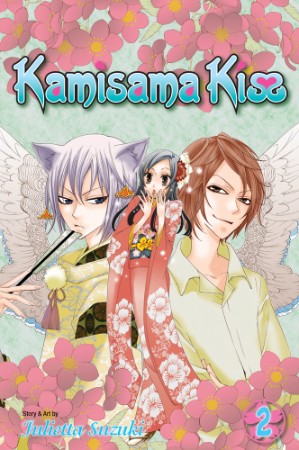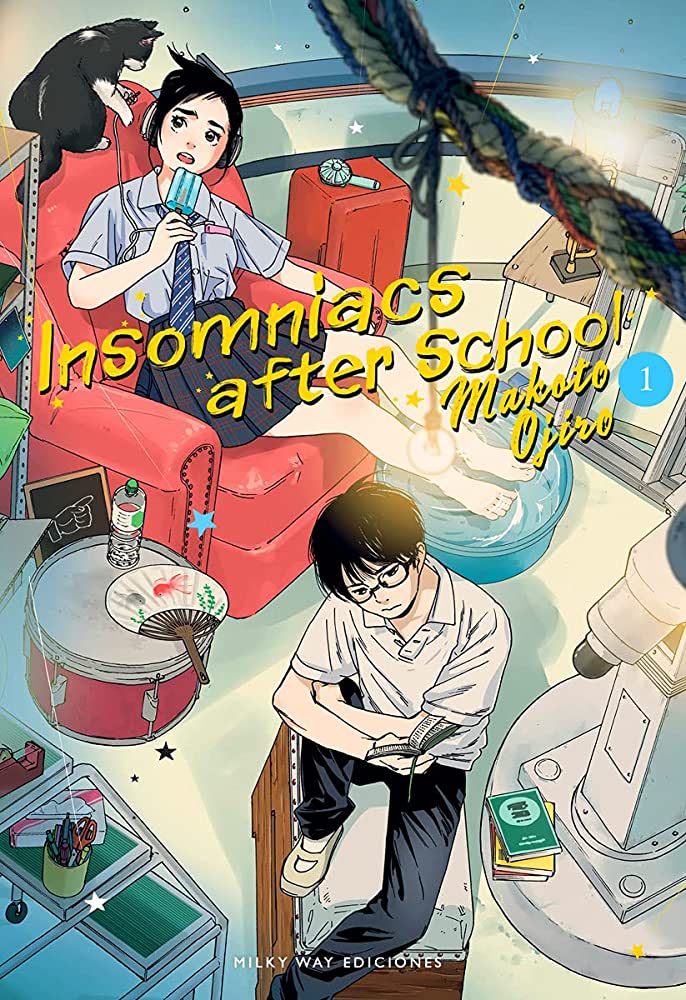Has Japan experienced a recent surge in pachinko-related child abandonment? I ask because Kamisama Kiss is, by my count, the fourth manga I’ve read in which a parent (a) racks up gambling debt (b) angers his creditors and (c) skips town, leaving his son or daughter to deal with the consequences. Nanami, Kamisama‘s plucky heroine, comes home from school to discover an eviction notice on the kitchen table alongside a hastily scrawled letter: “I’m going on a trip. Sorry. Don’t look for me. Dad.”
With no place to go — apparently, she has no relatives or friends with a couch — Nanami begins camping out in a local park, where she rescues a nervous man from an aggressive dog. As an expression of gratitude for “saving” him, Mikage offers Nanami a place to stay. What Nanami doesn’t know is that Mikage is the deity of a small, decrepit shrine, and is responsible for maintaining it, hearing visitors’ prayers, and warding off evil spirits — responsibilities he passes on to Nanami by planting a kiss on her forehead.
Once ensconced in the shrine, Nanami meets Mikage’s familiar, a haughty fox demon named Tomoe. You don’t need a PhD in Manga to guess what sort of chap Tomoe is: he’s good-looking, perpetually cranky, and quick to insult his new boss. The two bicker constantly about issues great and small, from Tomoe’s snotty tone of voice to Nanami’s inability to defend herself against demons. Over time, however, the two form a reluctant partnership, pledging to protect the shrine together.
If the story feels a little shopworn, the characterizations are vivid and engaging. Julietta Suzuki does a credible job of showing us how Nanami and Tomoe discover that they’re more alike than different; as their antagonistic banter reveals, both are stubborn, loyal, and concerned with other people’s welfare. Making those tart exchanges more entertaining is the fact that Nanami and Tomoe are equally matched; Nanami isn’t as verbally adroit as Tomoe, but she’s perfectly capable of tricking or browbeating him into following her orders.
Where Kamisama Kiss runs aground is in the predictability of its plotting. Every crisis — a threat to the shrine, the introduction of a romantic rival — builds to a crucial moment in which one character realizes that he or she can’t do without the other. Of course, neither is willing to label those feelings as love, forcing the story into an indefinite holding pattern in which the leads teeter on the brink of romance for dozens of chapters. Even the introduction of demonic rivals doesn’t do much to distract from the obvious plot turns, though it does provide Suzuki a swell excuse to draw fancy kimonos, angel wings, and androgynous boys. (I particularly liked the tengu who hid in plain sight by pretending to be a teen idol. Now I’d read a manga about him.)
I liked Kamisama Kiss, but found it totally forgettable — the umpteenth story in which characters from two very different worlds fall in love in spite of their differences. To be sure, there’s a certain pleasure in seeing an author put her romantic leads through their paces, but Suzuki adheres so strictly to the opposites-attract formula that the story practically writes itself.
Review copies provided by VIZ Media, LLC. Volume two will be released on March 2, 2011.
KAMISAMA KISS, VOLS. 1-2 • BY JULIETTA SUZUKI • VIZ • RATING: TEEN (13+)




Johanna says:
What are the other three, just out of curiosity?
Katherine Dacey says:
Hi, Johanna! Of the three books I had in mind, only one has been translated into English: Hayate the Combat Butler. Hayate takes a job working for a rich family after his parents try to pay off their gambling debts by pledging his organs to yakuza thugs. Of course, mom and dad don’t stick around to explain this arrangement; Hayate discovers their plan after his parents have flown the coop and thugs are hot on his trail.
Two titles I looked at in scanlation had similar opening gambits: Billion Dollar Girl, about a poor, abused young woman whose life is transformed by the handsome stranger who comes to repossess her family’s belongings. The other is Hadashi De Barack Wo Fume, in which the villain is an older brother who saddles his kid sister with his gambling debts and splits; again, a handsome stranger comes to her aid to magically lift her out of poverty. It’s a theme-and-variation on the classic “my family’s so poor they sold me into slavery/marriage/indentured servitude” plot line that opens such series as Gorgeous Carat (wealthy aristocratic family sells handsome son to his hot male cousin to pay off debts) and Gentleman’s Alliance Cross.
The trope is even more common than I realized. One enterprising blogger actually tabulated and listed the cumulative debts of about 10-15 popular manga characters. The original essay is in Japanese, but someone at ComiPress published a helpful English gloss on the essay: http://comipress.com/article/2007/03/09/1616. It’s a fun idea for an article, though it’s a little frustrating for English speakers, as almost none of the books have been translated into English so far.
Johanna says:
Thanks! I knew I’d seen that idea before, but of course as soon as I tried to remember, I blanked. It’s almost a parallel to Depression-era comedies, where so many people wanted some wacky event to get them out of debt as well.
Katherine Dacey says:
You’re welcome, Johanna! Your comment is now making me wish for a manga version of My Man Godfrey…
Johanna says:
Closest we ever got was Ralph & Sue Dibny, I fear, and now they’ve been destroyed as well.
Kris says:
I found it cute, though not stellar by any means yet. It has potential, though. It felt a lot like Black Bird to me, actually. A lighter, less smutty Black Bird, anyway.
Katherine Dacey says:
The two stories do have a lot in common, don’t they? Nanami is smarter and feistier than the lead character in Black Bird, though, so I didn’t find her relationship with Tomoe as objectionable as Misao’s with Kyo.
Aaron says:
I liked volume one but volume two just felt like a less sexually expolitive version of Black Bird with the love interst being a Kitsune instead of a Tengu over all a “mehh” title for me.
Katherine Dacey says:
Ah, but there’s a tengu in volume two! Who dresses like a rock star! And mopes! He’s kind of awesome, though he definitely springs from the same bad boy mold as the lead character in Black Bird. The difference here is that Nanami is a much tougher, spunkier heroine than BB’s Misao, and can give as good as she gets.
Jade Harris says:
David got me interested in this one, but my funds are tight enough that it’s nice to hear your opinion. Considering our split on titles like Library Wars and Stellar Six of Gingacho I might get more mileage than you. Then again, as I commented on David’s review, I can draw some very thick straight lines between a lot of the material here and in other series so there were already some flags up.
By the way, I get the feeling from talking with Japanese friends that pachinko is a little more taboo over there than we think because a lot of parlours are run by Yakuza. I think it’s just short-hand for the most logical way a normal person gets indebted to very dangerous people, just like bookies and horse-racing in stories over here.
Katherine Dacey says:
David, Melinda, and Michelle all liked Kamisama Kiss better than I did, if those extra endorsements are helpful. I found it totally agreeable, just not memorable enough for me to divert money away from some of my other ongoing series to collect it.
Hadn’t thought about the symbolic value of pachinko, but that’s a great observation. It’s amazing how much cultural shorthand gets lost in translation!